Unit 4 BODY LANGUAGE Intensive Reading说课课件[下学期]
文档属性
| 名称 | Unit 4 BODY LANGUAGE Intensive Reading说课课件[下学期] |  | |
| 格式 | rar | ||
| 文件大小 | 1.6MB | ||
| 资源类型 | 教案 | ||
| 版本资源 | 人教版(新课程标准) | ||
| 科目 | 英语 | ||
| 更新时间 | 2007-06-05 12:05:00 | ||
图片预览

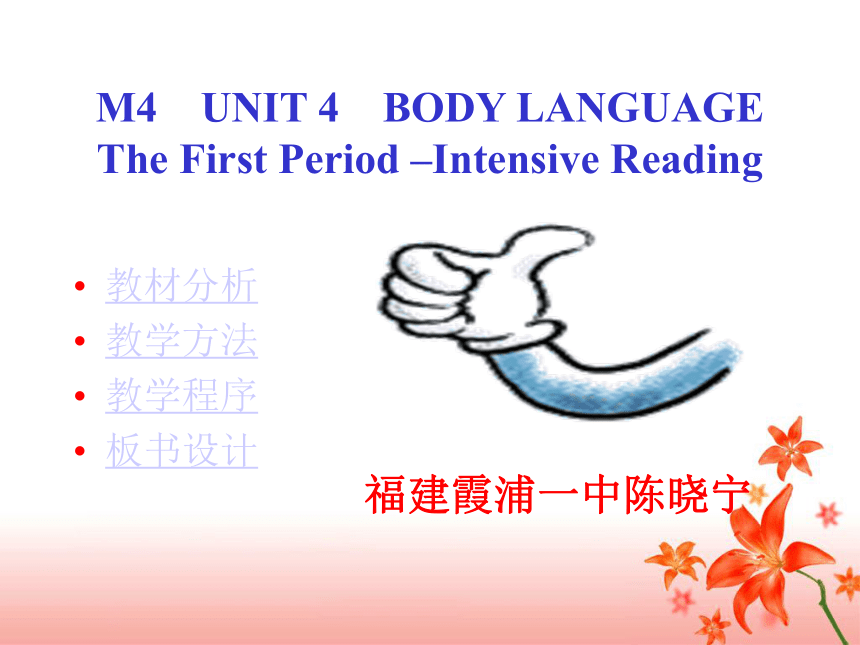

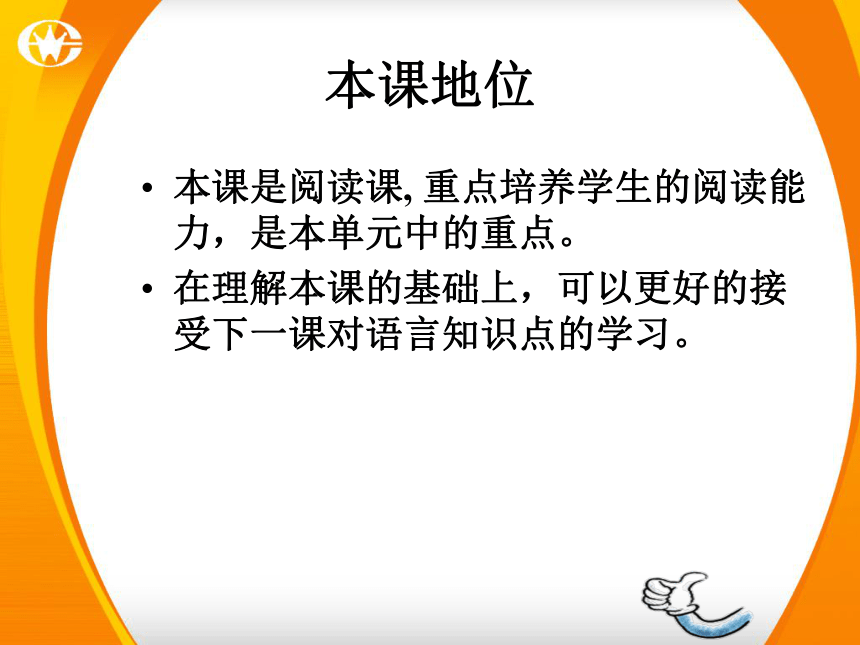
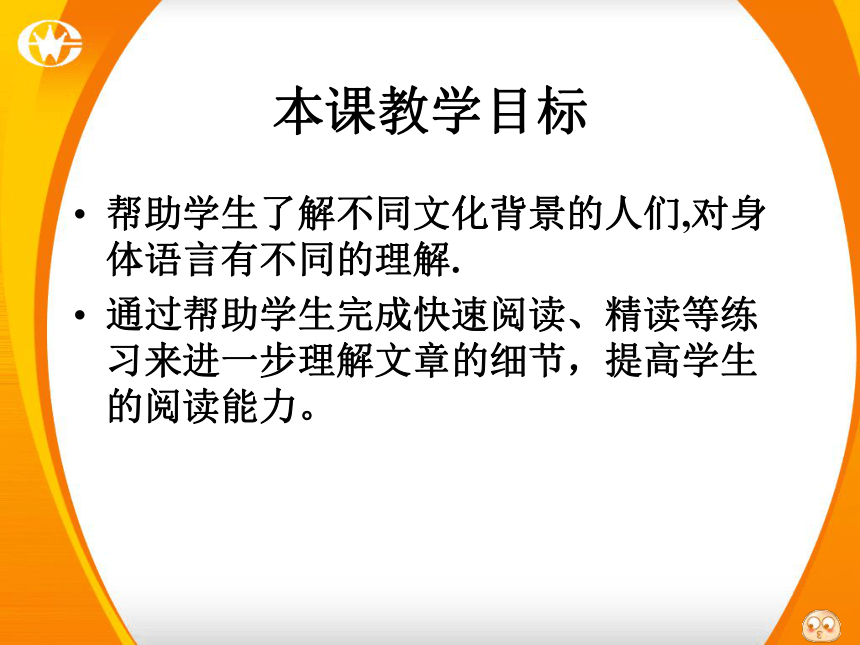

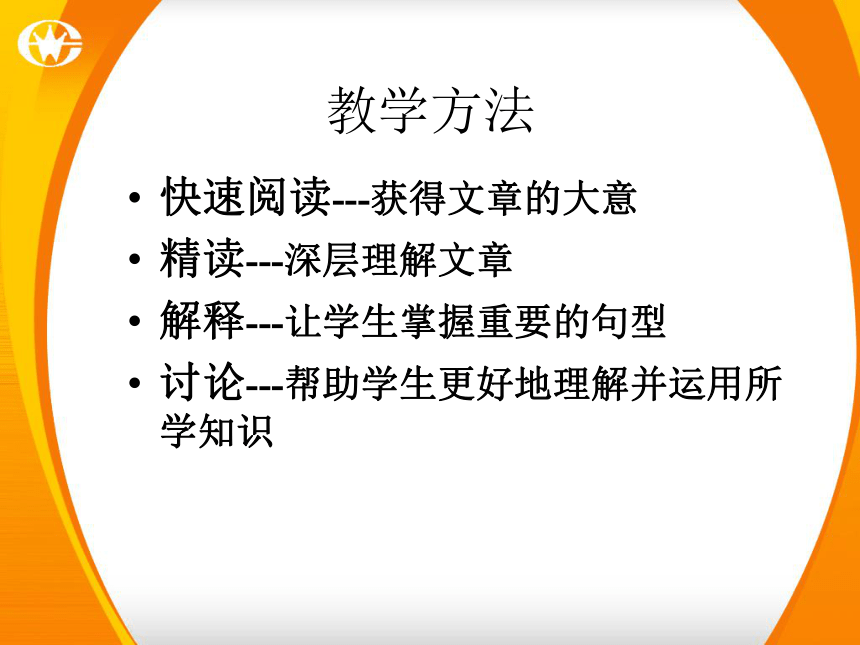
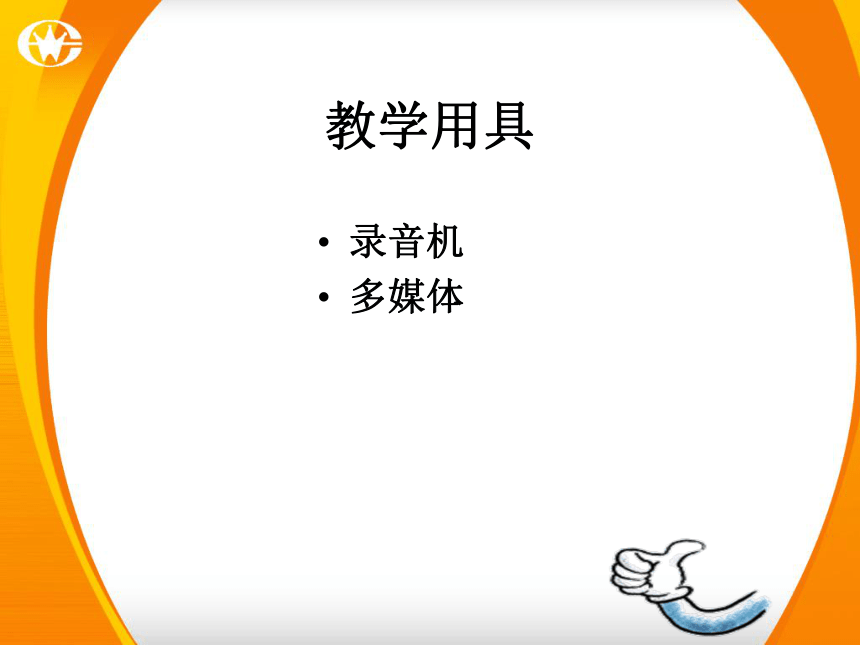
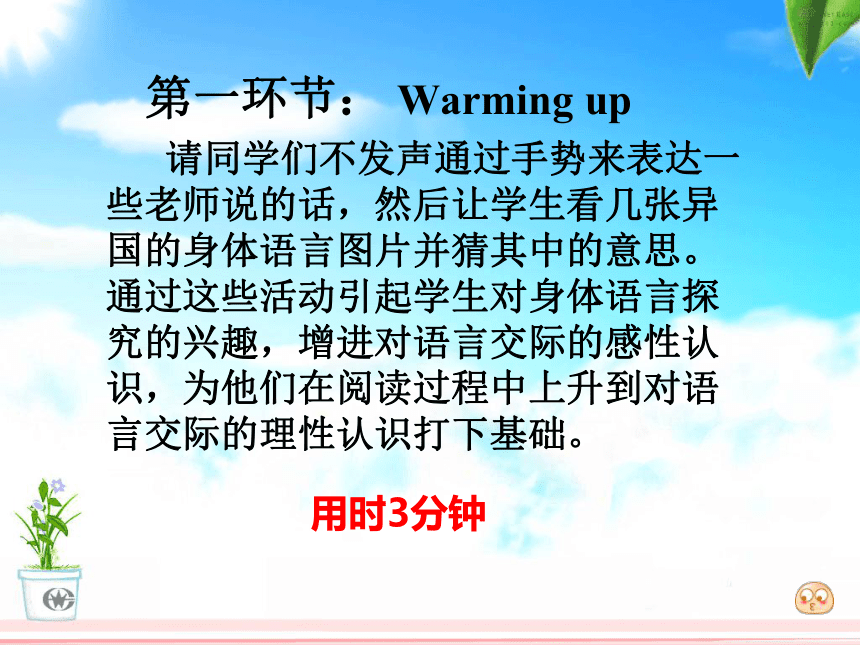
文档简介
课件29张PPT。Welcome福建霞浦一中陈晓宁M4 UNIT 4 BODY LANGUAGE
The First Period –Intensive Reading教材分析
教学方法
教学程序
板书设计福建霞浦一中陈晓宁本课地位
本课教学目标
本课重点难点本课地位本课是阅读课, 重点培养学生的阅读能力,是本单元中的重点。
在理解本课的基础上,可以更好的接受下一课对语言知识点的学习。本课教学目标帮助学生了解不同文化背景的人们,对身体语言有不同的理解.
通过帮助学生完成快速阅读、精读等练习来进一步理解文章的细节,提高学生的阅读能力。如何提高学生的阅读能力,并帮助学生解决本课的一些困难句型,以便让他们很好的理解文章。如:
1、“Not all cultures greet each other the same way,nor are they comfortable touching strangers or being too close or too far away.”
2、People from places like Spain, Italy or South American countries approach others closely and are more likely to touch them.本课重点难点教学方法快速阅读---获得文章的大意
精读---深层理解文章
解释---让学生掌握重要的句型
讨论---帮助学生更好地理解并运用所学知识教学用具录音机
多媒体 第一环节: Warming up
请同学们不发声通过手势来表达一些老师说的话,然后让学生看几张异国的身体语言图片并猜其中的意思。通过这些活动引起学生对身体语言探究的兴趣,增进对语言交际的感性认识,为他们在阅读过程中上升到对语言交际的理性认识打下基础。用时3分钟Well-doneOk stopquietGesturesVictory!
Can you guess what the following
gesture from Japan means ?angryCan you guess what the following gesture from France means ?I don’t believe you.
第二环节: Pre-reading
通过提供三个关于不同文化背景下“体态语”的问题,启发学生思考我们所学习的“语言”的目的、形式、功能。通过引导学生联系自己日常生活的实际,提高学生努力学习英语的积极性和自觉性;同时培养学生留心社会、关注生活的洞察力,为引导学生进一步“阅读”作好准备。用时3分钟Pre-reading1. What is the purpose of language?What do you think“BodyLanguage ”
means?
2. How can you tell if someone is sad even if they do not speak?
3. Give an example of how you can communicate a feeling to someone who does not speak your language.
第三环节:Reading
这是重点阅读环节,分为快速阅读和精读两个部分。主要让学生阅读 一篇介绍性(记叙文)体裁的文章,主要介绍了各种文化背景下的“体态语”的异同,为学生提供了来自不同国度、不同语言文化背景的“体态语”及其在交际中的异同和影响的具体例证。学生也可以结合自己在语言交际中所遇到的实际例子来进一步理解“交际,毫无问题可言吗?”这一主题。用时18分钟 1. What is the main idea of the text?
A. There are different customs in
different countries.
B. Foreigners should follow the
customs of the country where they
are visiting.
C. People use body movements to send
messages and different body
movements have different meanings.
D. The importance of knowing customs. Fast-reading2. If two men stand close to each other while talking, they cannot be from _____.
A. an Arab country B. USA
C. Britain D. Russia 此环节为快速阅读,目的在于帮助学生培养迅速获得文章信息的能力。1.Why are the people visiting China?
2.What parts of the world are not represented by the visitors?
3.Why is Julia Smith surprised?
4.Why do you move back from Ahmed Aziz?
5.What do French people often do when they meet people they know?Intensive-reading这5个问题旨在检查学生对阅读材料细节的理解6.Can we expect people everywhere to act the same? Why?
7. Why do you think we need to study body language?6-7问题旨在引导学生对“体态语”的意义及文化差异的思考8、Is the main character male or female?How do you know?第8个问题检查学生能否通过细节进行推理判断第四环节 : Discussion用时5分钟 请同学们根据文章里所学的内容,表演出来自Columbia与Britain,Japan与Canada,Jordan与France的人在问候时因为所用的身体语言不同而产生的冲突。通过讨论与归纳,进一步熟悉和掌握“体态语”在不同语言文化交际中的作用和意义。
此环节的目的是为了帮助学生进一步熟悉和理解文化差异,并训练英语口语表达能力
My boss has sent me to Pudong Airport to meet
some _________people from many parts of the
world, who are interested in the ____________ of
The economy in china.
The first one to arrive is Mr. Garcia from
Columbia with Julia Smith, a British lady,
__________behind closely. I __________them to each
other and I’m _________to see Mr. Garcia come up
to Ms Smith. Just then, in comes a visitor from
Japan, smiling at the time when the Canadian,
Gorge Cook _________out his hand to him. businessdevelopmentfollowingintroducesurprisedreaches第五环节Text Retelling: 此项任务重点是培养学生归纳总结的能力,并能对本课的主要内容进行复习。用时6分钟第六环节 Language Points Focus1. “Not all cultures greet each other the same way,nor are they comfortable touching strangers or being too close ot too far away.”
2. People from places like Spain, Italy or South American countries approach others closely and are more likely to touch them.用时5分钟此环节是为了帮助学生解决本课的一些困难句型,以便让他们很好的理解文章 第七环节
Questions time用时2分钟让学生自由提问 此环节的目的是为了帮助学生扫清在阅读过程中遇到的一些障碍Homework1. Recite the new words in the text. 2. Go over “Learning about language” 1. 2. And 3 on P27-28.
此项任务重点在于安排学生回去巩固本课的知识点,并为下一课的语言点学习打好基础。第八环节用时2分钟1. Warming up
2. Pre-reading
3. Reading
(1) Fast reading
(2) Intensive reading
4. Discussion
5. Retell the story
6. Language points focus
7. Questions time
8. Homework
Thanks福建霞浦一中陈晓宁
教学方法
教学程序
板书设计福建霞浦一中陈晓宁本课地位
本课教学目标
本课重点难点本课地位本课是阅读课, 重点培养学生的阅读能力,是本单元中的重点。
在理解本课的基础上,可以更好的接受下一课对语言知识点的学习。本课教学目标帮助学生了解不同文化背景的人们,对身体语言有不同的理解.
通过帮助学生完成快速阅读、精读等练习来进一步理解文章的细节,提高学生的阅读能力。如何提高学生的阅读能力,并帮助学生解决本课的一些困难句型,以便让他们很好的理解文章。如:
1、“Not all cultures greet each other the same way,nor are they comfortable touching strangers or being too close or too far away.”
2、People from places like Spain, Italy or South American countries approach others closely and are more likely to touch them.本课重点难点教学方法快速阅读---获得文章的大意
精读---深层理解文章
解释---让学生掌握重要的句型
讨论---帮助学生更好地理解并运用所学知识教学用具录音机
多媒体 第一环节: Warming up
请同学们不发声通过手势来表达一些老师说的话,然后让学生看几张异国的身体语言图片并猜其中的意思。通过这些活动引起学生对身体语言探究的兴趣,增进对语言交际的感性认识,为他们在阅读过程中上升到对语言交际的理性认识打下基础。用时3分钟Well-doneOk stopquietGesturesVictory!
Can you guess what the following
gesture from Japan means ?angryCan you guess what the following gesture from France means ?I don’t believe you.
第二环节: Pre-reading
通过提供三个关于不同文化背景下“体态语”的问题,启发学生思考我们所学习的“语言”的目的、形式、功能。通过引导学生联系自己日常生活的实际,提高学生努力学习英语的积极性和自觉性;同时培养学生留心社会、关注生活的洞察力,为引导学生进一步“阅读”作好准备。用时3分钟Pre-reading1. What is the purpose of language?What do you think“BodyLanguage ”
means?
2. How can you tell if someone is sad even if they do not speak?
3. Give an example of how you can communicate a feeling to someone who does not speak your language.
第三环节:Reading
这是重点阅读环节,分为快速阅读和精读两个部分。主要让学生阅读 一篇介绍性(记叙文)体裁的文章,主要介绍了各种文化背景下的“体态语”的异同,为学生提供了来自不同国度、不同语言文化背景的“体态语”及其在交际中的异同和影响的具体例证。学生也可以结合自己在语言交际中所遇到的实际例子来进一步理解“交际,毫无问题可言吗?”这一主题。用时18分钟 1. What is the main idea of the text?
A. There are different customs in
different countries.
B. Foreigners should follow the
customs of the country where they
are visiting.
C. People use body movements to send
messages and different body
movements have different meanings.
D. The importance of knowing customs. Fast-reading2. If two men stand close to each other while talking, they cannot be from _____.
A. an Arab country B. USA
C. Britain D. Russia 此环节为快速阅读,目的在于帮助学生培养迅速获得文章信息的能力。1.Why are the people visiting China?
2.What parts of the world are not represented by the visitors?
3.Why is Julia Smith surprised?
4.Why do you move back from Ahmed Aziz?
5.What do French people often do when they meet people they know?Intensive-reading这5个问题旨在检查学生对阅读材料细节的理解6.Can we expect people everywhere to act the same? Why?
7. Why do you think we need to study body language?6-7问题旨在引导学生对“体态语”的意义及文化差异的思考8、Is the main character male or female?How do you know?第8个问题检查学生能否通过细节进行推理判断第四环节 : Discussion用时5分钟 请同学们根据文章里所学的内容,表演出来自Columbia与Britain,Japan与Canada,Jordan与France的人在问候时因为所用的身体语言不同而产生的冲突。通过讨论与归纳,进一步熟悉和掌握“体态语”在不同语言文化交际中的作用和意义。
此环节的目的是为了帮助学生进一步熟悉和理解文化差异,并训练英语口语表达能力
My boss has sent me to Pudong Airport to meet
some _________people from many parts of the
world, who are interested in the ____________ of
The economy in china.
The first one to arrive is Mr. Garcia from
Columbia with Julia Smith, a British lady,
__________behind closely. I __________them to each
other and I’m _________to see Mr. Garcia come up
to Ms Smith. Just then, in comes a visitor from
Japan, smiling at the time when the Canadian,
Gorge Cook _________out his hand to him. businessdevelopmentfollowingintroducesurprisedreaches第五环节Text Retelling: 此项任务重点是培养学生归纳总结的能力,并能对本课的主要内容进行复习。用时6分钟第六环节 Language Points Focus1. “Not all cultures greet each other the same way,nor are they comfortable touching strangers or being too close ot too far away.”
2. People from places like Spain, Italy or South American countries approach others closely and are more likely to touch them.用时5分钟此环节是为了帮助学生解决本课的一些困难句型,以便让他们很好的理解文章 第七环节
Questions time用时2分钟让学生自由提问 此环节的目的是为了帮助学生扫清在阅读过程中遇到的一些障碍Homework1. Recite the new words in the text. 2. Go over “Learning about language” 1. 2. And 3 on P27-28.
此项任务重点在于安排学生回去巩固本课的知识点,并为下一课的语言点学习打好基础。第八环节用时2分钟1. Warming up
2. Pre-reading
3. Reading
(1) Fast reading
(2) Intensive reading
4. Discussion
5. Retell the story
6. Language points focus
7. Questions time
8. Homework
Thanks福建霞浦一中陈晓宁
同课章节目录
